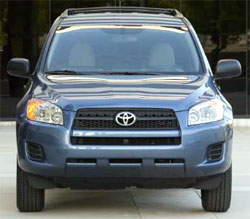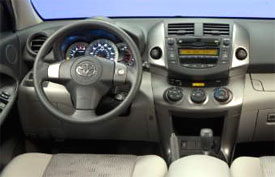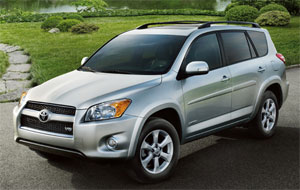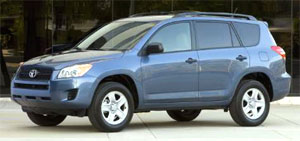2009 Toyota RAV4
The introduction of the small, 1996 Toyota RAV4 started a big revolution. It was the first SUV to be based on a car-like unitized chassis instead of a traditional truck-style frame. Well that idea has now spread to utilities of all sizes, along with a new vehicle description, the crossover. But, the RAV4 saunters on, and every year it seems to get just a little bit better, and as the third generation RAV4 arrives at mid-life, that’s truer than ever.
It’s understandable why Toyota has resisted the temptation to tinker too much with the 2009 RAV4. This pioneering compact crossover sells well and has legions of highly satisfied fans that keep coming back for more. So, any change has to be well chosen and meaningful. Like most vehicles mid-way through their life cycle, the latest RAV4 dons a minor facelift, adds a dose of power, and a bump-up in safety and user-technology. What isn’t changed is its flexibility. The RAV4 was the first compact crossover utility to offer 3-row, 7-passenger capacity.
On the outside, the new RAV4’s familiar front-end has been altered with a taller grille opening, a bumper with deeper fog light inserts, and pointier headlight housings. and the rear-view is now dressed with redesigned tail lamps. While the Limited model gets new turn signal mirrors, our Sport grade tester featured a unique rear spoiler. Wheels still range from 16 to 18 inches, but include a new 17-inch alloy design.
 As before two engines are on tap; a new 2.5-liter 4-cylinder replaces the previous 2.4. Output is now 179 horses - a jump of 13 - and 172 pound-feet of torque - a bump of 7. Our tester sported the carryover 3.5-liter V6 boasting 269 horses and 246 pound-feet of torque. Max towing stands at 3,500 pounds.
As before two engines are on tap; a new 2.5-liter 4-cylinder replaces the previous 2.4. Output is now 179 horses - a jump of 13 - and 172 pound-feet of torque - a bump of 7. Our tester sported the carryover 3.5-liter V6 boasting 269 horses and 246 pound-feet of torque. Max towing stands at 3,500 pounds.
We’re surprised transmissions haven’t been updated. Only 4 speeds for the automatic fitted to the 2.5, and a 5-speed auto for the V6. Power goes to either to the front-wheels, or to on-demand four-wheel drive system with limited slip rear differential on the 2.5. The V6 substitutes a manual locker that splits torque 55% front/45% rear.
If you’re after the best gas mileage, we recommend the front-drive 2.5 model. Government Fuel Economy Ratings are 22 city/28 highway on regular, and owners are seeing an impressive 28.8. Our thirstier AWD V6 rates at 19 city/26 highway, and we achieved an expected 22.9 miles-per-gallon in our test. The Energy Impact Score for our V6 is a moderate 16.3 barrels of oil consumed per year and its Carbon Footprint measures 8.7 annual tons of CO2 emitted.
But, at the track, our RAV4 V6 surprised us with a 0 to 60 run of only 6.4 seconds, about a half second faster than our 2005 test, and a 14.8 second quarter-mile ending at 99 miles-per-hour, numbers that leave most small UTEs coughing in the dust. With four-wheel independent suspension, electric power steering, and standard stability and traction control, the RAV4 keeps its reputation as an able handler, though it does move through the cones feeling a little top-heavy.
As before, the RAV4’s higher degree of firmness yielded a ride that is more UTE than car. Almost harsh at times and falling short of its plusher, more comfortable rivals like the Honda CR-V. Stopping power, however, is impressive. The standard all-disc setup with ABS and Brake Assist averaged a short 125 feet from 60 to 0. Halts were super straight, showing minimal signs of fade.
In terms of our V6 being truly off-road capable, along with the manual locker, is 7.5 inches of ground clearance and standard Hill-Start Assist and Downhill Assist Control.
 Diving inside the RAV4, we find an interior that remains virtually the same as before, meaning spacious and well-equipped. The multi-level dash with bold switchgear, and metallic trim, will continue its appeal to younger buyers.
Diving inside the RAV4, we find an interior that remains virtually the same as before, meaning spacious and well-equipped. The multi-level dash with bold switchgear, and metallic trim, will continue its appeal to younger buyers.
For 2009, occupant safety has been elevated with new active front head restraints. Standard features across all models, Base, Sport, and Limited, include tilt-telescoping steering wheel, air conditioning, CD stereo with MP3 input, and three 12-volt power outlets.
As before, there are lots of smart storage space and ten well-placed cup holders. New to the long list of options is a rear-view backup camera and a lower-cost navigation system. The adult comfortable second row both slides and reclines, with a required 60/40 fold for cargo versatility. The optional third row split bench is only suitable for small children and they have to crawl on their hands and knees to get there. But lay all the seat backs flat and total cargo space maxes out at a big 73 cubic feet. Access is by a rear door, and the V6 Sport Appearance Package now trades the rear tire carrier for run-flats.
RAV4 prices begin at $22,245 for a 4-cylinder. Add $1,400 for all-wheel drive. V6 models begin at $24,280. And, note, dealer discounts are plentiful. Change for the sake of change is usually unwelcome. But, for the 2009 Toyota RAV4, its short list of subtle and correct improvements is welcome. It’s now stronger, safer, and sharper to the eye. And best of all, pretty much the same.
 Recent news that Tesla will help Toyota engineer an all-electric RAV4 has once again turned the spotlight on this pioneering compact crossover utility. Our last road test of the Toyota RAV4 was the 2009 edition which bore a minor facelift, including a new bumper, and new light designs front and rear.
Recent news that Tesla will help Toyota engineer an all-electric RAV4 has once again turned the spotlight on this pioneering compact crossover utility. Our last road test of the Toyota RAV4 was the 2009 edition which bore a minor facelift, including a new bumper, and new light designs front and rear.
What pleased us more, however, was a boost in power. A 179 horsepower 2.5-liter replaced the previous 2.4, while the 3.5-liter 269-horsepower V6 was unchanged. Our biggest disappointment was in automatic transmissions. While rivals were unveiling 6-speeds, the RAV4 stuck with a four- speed for the 2.5 and a five-speed for the V6. Still, RAV4 fuel economy remained very good for any utility.
We continued to be impressed with the versatility of the RAV4. It was among the first small utes to offer three-row, seven-passenger seating. Even if the back row is only for smallish children, it’s still nice to have when you need to separate your brood.
With four-wheel independent suspension, electric power steering, and standard stability and traction control, the RAV4 kept its reputation as an able handler, though it does move through tight corners feeling a little top-heavy.
That was two years ago. For our 2011 update, we find the Toyota RAV4 holding to the creed: “If it’s not broke, don’t fix it!” It saunters on looking pretty much the same outside, including the rear tire carrier, and inside. Since we last tested the RAV4, a rear view mirror backup camera display became available on the base model. For 2011, the RAV4 continues to be all about value. For only $470, the Sport trim’s Enhancement Value Package adds such niceties as a power sunroof, roof rails with crossbars, steering wheel controls, and a 6-disc CD stereo with XM radio.
The latest RAV4 reminds us that it’s on-road ride is not as smooth as some, but on the other hand, we know from past experiences that it can handle tougher off-road assignments much better than many all-wheel drive rivals.
Base prices for the 2011 Toyota RAV4 range from $22,735 for a Base front driver, to $29,045 for an all-wheel drive Limited. And that’s the bottom line for this MotorWeek Auto Update.
Specifications
- Engine: 3.5-Liter V6
- Horsepower: 269
- Torque: 264 Lb Feet
- 0-60 MPH: 6.4 Seconds
- 1/4 Mile: 14.8 Seconds @ 99 MPH
- 60-0 MPH: 125 Feet
- EPA: 19 MPG City/ 26 MPG Highway
- Mixed Loop: 22.9 MPG
- Energy Impact: 16.3 Barrels Oil/Yr
- CO2 Emissions: 8.7 Tons/Yr






